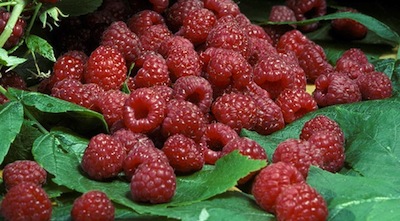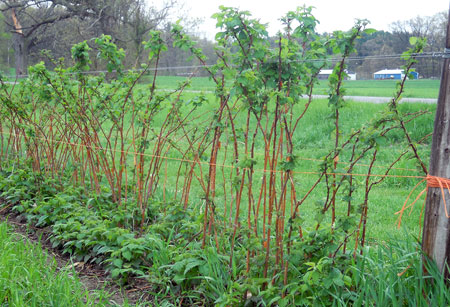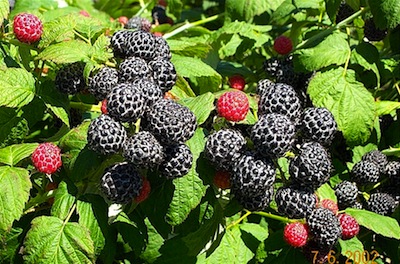Raspberries in our Mid-Atlantic Region
By Joe Francis, Fairfax Master Gardener
 Soft raspberries can be successfully grown in this region with bursts of attention twice each year. They will take all, and more, of their allotted growing space, but pruning shear applications at the correct time will keep them at bay. Equipped with shallow root systems at a 3- to 4-inch depth, they need at least 1 inch (20 cm) of weekly rainfall from blooming until harvest (a span of 32 to 54 days) to attain maximum fruit sizes and bountiful yields. Diminished water translates directly into smaller and crumbled fruit.
Soft raspberries can be successfully grown in this region with bursts of attention twice each year. They will take all, and more, of their allotted growing space, but pruning shear applications at the correct time will keep them at bay. Equipped with shallow root systems at a 3- to 4-inch depth, they need at least 1 inch (20 cm) of weekly rainfall from blooming until harvest (a span of 32 to 54 days) to attain maximum fruit sizes and bountiful yields. Diminished water translates directly into smaller and crumbled fruit.
Growing area preparation
Do a soil test to see what the growing area has to offer. If you have a soil pH challenge, make an effort to reach a pH of 5.6 to 6.2. Full sun is fine and will yield a larger crop, if plant relief is provided from the very hot sun in mid- to late afternoon. Selection of a partially shaded site with about six hours of sun will produce a smaller yield and happier plants. Since this growing area will not be disturbed for several years, a deep penetration of composted materials will provide lasting results. If you are taking the long view for a planting, with a timeline of a decade, start with each 2-foot-wide row tilled seven or eight times to a depth of 6 to 8 inches (15 to 20 cm), with composted matter reincorporated with alternate tilling cycles. If your time horizon for soft berry culture is about five years, as few as three repetitions of the till and soil amending process could suffice.
Install 5-foot (1.5 m) robust metal fence posts in the row at about 8-foot intervals (2.5 m). String two aluminum fencing wire strands, and leave several extra rounds at each post for future repairs. These strands should be at the 2.5- and 4.5-foot level and will serve as the anchoring point for the growing canes. If several rows are used, the beginning post positions for each row ought to be spaced at 6 feet horizontally (1.8 m) to allow ample aisle space for maintenance, harvesting and air circulation.

Raspberry canes growing on fence
New canes are planted in the fall or early spring and for the most part will not yield a crop that first year.
Black raspberry
Black raspberries were a favorite in the residential gardens of the early to mid-20th century, but their listings are not plentiful in today’s catalogs. However, the darling clones ‘Cumberland’ of the 1920 to 1960 era remain in the plant sale inventories. We had a well-established stand of these on our property when we took possession in 1970.
The fruit appears on the prior year’s new growth and is ripe in June. There is about a three-week picking cycle. Remove the spent fruiting canes at ground level shortly after the harvest is completed.
 The new fruiting canes emerge from the base plant in May and rapidly reach 6 feet (1.8 m). These canes need to be loosely tied to the support wires. In early July, top the cane at about 5 feet (1.5 m). This will prompt lateral growth in the upper cane segment. The new growth will form a pendulous mass as it races to reach ground level (think bad hair day); this is its way of establishing a new plant by keiki growth. During late February, top dress the planted row with composted mulch.
The new fruiting canes emerge from the base plant in May and rapidly reach 6 feet (1.8 m). These canes need to be loosely tied to the support wires. In early July, top the cane at about 5 feet (1.5 m). This will prompt lateral growth in the upper cane segment. The new growth will form a pendulous mass as it races to reach ground level (think bad hair day); this is its way of establishing a new plant by keiki growth. During late February, top dress the planted row with composted mulch.In March, count out from the laterals on the main stem 10 to 12 leaf axil buds and sever the pendulous growth. Follow this cane to its newly rooted tip, and dig it up to be replanted, shared or discarded. The row will look like a series of opened umbrellas without covering. Be certain to remove any spindly vertical growth; the stout canes will benefit from this thinning. I find long sleeves and leather gloves to be advantageous.
Do not introduce wild berry stock into your setting, because an aphid vector attracted to wild raspberries can bring disease to domestic plantings. (An insect that transmits a disease is known as a vector.) The aphid Amphorophora agathonica is considered the exclusive purveyor of the mosaic virus, a complex compilation of virus strains. It is attracted to wild raspberries from abandoned cultivation usually found in hedgerow settings. Subsequent visits to the cultivated patch spread the infection. All new plantings ought to be 500 to 1,000 feet away (150 to 300 m) from these abandoned growths.
You should also avoid the use of a plot that has been planted with members of the Solanaceae family (potatoes and tomatoes) within the past four or five years. The soil they grew in can host pathogens or diseases of the previously cultivated plants, and their presence affects the raspberry crop yield. This is especially true with the black and purple raspberry plantings.
Prompt and thorough sanitation in March and July will, for the most part, ensure a trouble-free planting.
Red raspberry
The site preparation advice given above applies to both red and black raspberries. Red raspberries prefer full sun but benefit from some relief in late afternoon. These berries bear fruit on new growth in the same season. The fruit appears on the tip of the new growth, in a cluster fanned out like a human hand. Red raspberries benefit mightily from mulch covering to conserve moisture. Small, crumbling berries indicate a lack of attention to water requirements. The berries are developing during August and September, usually a dry season in the mid-Atlantic region. The plants need deep watering beginning in mid-August for about six weeks.
Plant propagation is by growth of underground stems, or stolons. Transplanting the young new growth into the cultivated row will prove rewarding for both maintenance and harvest.
Leave the spent fruiting head on the plant during the winter, and remove it when the buds on the cane begin to swell in March. A second fruiting crop will come on the prior-year cane, for harvest in June. There is a substantial difference in the taste of the fall and spring crops, the former being more intense. Remove the spent cane after the spring picking.
 Yellow raspberry
Yellow raspberryThis one is an interesting challenge. We raise the cultivar ‘Fall Gold.’ Its growth habits are much like the red raspberry, with underground propagation and a preference for spring planting. Site preparation is the same as for the red and black varieties. This yellow raspberry does best in semi-shade and cannot tolerate full afternoon sun. We use a very thick leaf mulch, providing a 4-inch covering (10 cm) to both conserve moisture and keep the root system cool. Deep watering begins in July and continues well into September. As with the red berry, the cane provides two crops.
This clone rewards us with an intensely sweet and delicate berry. (Bush to mouth is the best choice.) The intense flavor does not last for many hours after picking, and the berry loses its delicate, sweet taste if canned. We have tried several other cultivars and found them to have great appearance virtues but no meaningful taste.

Purple raspberry
A recent (2010) addition to our holdings, the hybrid ‘Royalty Purple’ raspberry was quite a satisfactory find. It is a hybrid cross between a black and red raspberry, made at Cornell. Its fruiting harvest is in August. It has extra-large fruit that performs well in the kitchen and is not overly sweet. It propagates through underground stolons. We do light leaf mulching, keep it shaded from the late afternoon sun and make no major effort at supplemental watering. It is happy with a pH of 6.2 to 6.8. Other than the annual time spent pruning canes after fruiting and fastening new cane growth, this is about as maintenance free as one could dream possible.
Diseases
The major cause of reduced fruit yields in raspberry production is thought to be viral infections. There are four main viral diseases that affect raspberries. These infections are introduced by aphids, of which many are delivered to the planting by the force of wind. It is imperative that your new planting stock is certified to be virus free.
As previously mentioned, ensure that there are no stands of “wild” (abandoned from earlier plantings) raspberries within a circumference of 500 to 1,000 feet (150 to 300 m). The aphid Amphorophora agathonica is thought to be the principal vector for the mosaic virus, a combination of several viruses. It is deemed to have the greatest impact on production in black and purple berry stock.
Leaf curl virus is readily detectable by small leaves tightly curled downward. It is less common than the mosaic virus but much more destructive, and infected plants need be destroyed immediately.
Raspberry streak virus affects only black raspberries. There is a gradual decline in plant and fruit size, and the fruit ripens unevenly (white spots) and is dull and seedy. The infection is common north of the Mason-Dixon line.
Tomato ringspot virus found in major production areas affects the red raspberry. Its symptoms are smaller-sized plants and crumbly berries because the fruitlets that make up the fruit do not develop. The virus is transmitted through the soil by the dagger nematode. Plots used for potato, tomato and eggplant should be avoided for three to five years before planting raspberries.
Because red raspberries can be infected without manifesting symptoms, it is imperative that red stock be planted downwind and as far away as possible from the black and purple plantings. This will minimize windborne aphid mobility. Scout the crop in July and September for virus-infected plants and remove them.
Resources
• Training and Pruning Raspberries and Blackberries, University of Maryland Extension
• Small Fruit in the Home Garden, Virginia Cooperative Extension Publication 426-840
• Pest Management Guide, 2021, Virginia Cooperative Extension
• Virus Diseases of Brambles in the Midwest, University of Illinois Extension
… updated 2021